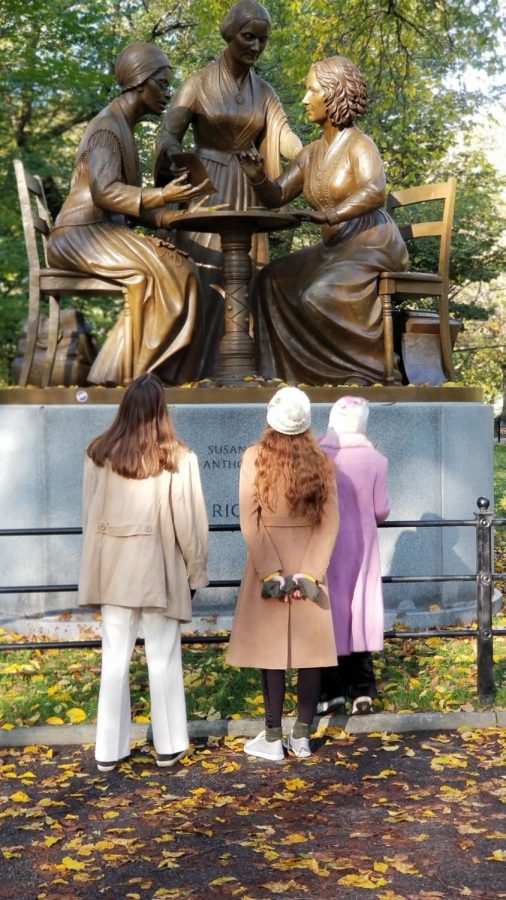The Future is Hers
November 4, 2020
I rise before the sun, but I don’t mind. Grab my coat, remember my hat – “Lia, don’t forget to wear your white sneakers!” We wipe the icy frost from the car’s windshield and race to the station. Hop out, go to track A; we’re catching the 6:59 train, an express! “Please stand clear of the closing doors,” plays over the train’s speakers. We just made it, and I sink into my seat, faintly exhausted. I close my eyes – but only for a moment…have we arrived? Yes? Wow. Okay, then. As we stand up and slowly exit the train car, I am momentarily stunned by the contrast of the dim, torpid streets we have left for the constant, busy hum of Penn Station. “Hey, Lexi: Where is the statue again?” “The Statue’s in the Literary Walk, so we’ll take the 1 train and walk to 72nd Street to enter the park, then we’ll go to the Bethesda Fountain and the Literary Walk.” She replies. We stride up the staircases and enter the section to take the 1. The subway carries us to another station and leaves us there, whisking away. We walk out of the station, emerging in the early morning sunlight.
We walk past the New York City regulars: a jogger rubbing her hands to keep warm as she waits to cross the street; a man holding a bagel and pulling his scarf a little tighter to squeeze out the chilled air; the dogs and dog-owners holding their regular morning meetings. When we’re walking into the park, I could see the city poodles had called a conference and had brought their humans along to be coffee and dog biscuit carriers. For right along a path, poodles of all sizes, colors, and cuts had gathered at the side, sniffing and wrestling, barking over the most imperative issues – their humans talking among themselves and supplying refreshments for the important city poodles.
The leaves in Central Park had been turning, and the canopy above, likewise the road below, was ablaze with October’s final glories. Like the beautiful dancer who grows old with grace, the year saves her most festive colors and dresses for her final show: Autumn. We stroll along the leafy paths and admire the durable, sturdy flowers that have the grit to bear the autumnal cold and wind. Crossing the Bethesda Terrace, we listen as Mom points out the boathouse, the bridge, and the canoe shed. The wind blows gently yet nips fiercely at our faces when we turn to face it, walking down Literary Walk, searching for the statue that drew us here, early on this morning. It does not take long to spot them. At fourteen feet tall and consisting of three detailed, lifelike figures, the statue is impressive in size and artistic style. The faces of Sojourner Truth, Susan B. Anthony, and Elizabeth Cady Stanton look out, beyond anything in this park. I read the inscription on the bottom of the statue, and feel a sense of fulfillment; yes, the Bronze Ceiling has been officially shattered.
The Women’s Rights Pioneers Monument, created by sculptor Meredith Bergmann, honors the equality across genders movement and the lives of suffragists Sojourner Truth, Susan B. Anthony, and Elizabeth Cady Stanton. The statue is accompanied by a sign which contains a code, that, when scanned, plays a recorded piece. The recording is a narration of what is depicted in the statue, and a small biography on each woman in the statue. The statue represents the components of a movement: speaking, organizing, and writing. Sojourner Truth, her mouth opened with intention, represents speaking. Susan B. Anthony, standing at the table with papers in her hands and scattered around her, represents organizing, and Elizabeth Cady Stanton, with the mighty quill in hand, represents writing, another essential part of an effective movement. The Women’s Rights Pioneers Monument is the first monument ever erected in Central Park that shows real-life women (in the past the only female statues were fictional characters). This previously accepted standard was called the Bronze Ceiling, revealing the underrepresentation of women in history, public education, and public art.
Listening to their stories, and hearing about what they fought for, I saw how my life is affected by what they did. It reminded me of how today, voting is an essential right that is one that has to be actively used and protected to keep. As Vice Presidential Candidate Kamala Harris said: “Your vote is your voice, your voice is your vote, there is so much at stake, don’t let anyone ever take your power.” My sisters and I stand before the statue. I can’t help but notice the “I Voted” sticker that someone put the front of the statue. I gaze up to meet the wise eyes of the women above me, and all who came before me. I stand on their shoulders. What I can do today is because of what they did in their days. My mom walks over to us and softly says, “The future is yours, you know.”
